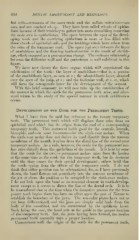Page 624 - My FlipBook
P. 624
634 DENTAL EMBRYOLOGY AND HISTOLOGY.
lial cells—remnants of the outer tunic and the stellate reticulum—are
seen, and are marked xch. ep. They have been called whorls of epithe-
lium because of their tendency to gather into nests resembling somewhat
the nests seen in epithelioma. The space between the apex of the devel-
oping tooth and the overlying epithelium is more or less filled with
these whorls of epithelial cells and the buddings which have arisen from
the sides of the temporary cord. The space (.s^^) seen between the layer
of ameloblasts and the forming tooth-structure is the result of shrink-
age, which occurred as a post-mortem change. The intimate relationship
between the follicular wall and the periosteum is well exhibited in this
figure.
We have now shown the three organs which will superintend the
calcification of the tooth : the layer of ameloblasts—that is, a portion
of the ameloblastic layer, as seen at a ; the odontoblastic layer, situated
over the apex of the pulp, at o ; and the follicular wall, at c. ct, which
will form the osteogenetic layer for the development of the cement.
With this brief summary, we will now take up the consideration of
the manner in which the cords for the permanent teeth arise, and after-
ward return to the study of the special manner in which calcification
occurs.
Development of the Cord for the Permanent Teeth.
What I have thus far said has reference to the twenty temporary
teeth. The permanent teeth which will displace these arise from an
epithelial cord which has its origin from the cord of a corresponding
temporary tooth. This statement holds good for the centrals, laterals,
bicuspids, and—in some instances—for the sixth-year molars. When
the sixth-year molar does not derive its cord directly from the mucous
membrane of the mouth, it arises from the distal face of the second-year
temporary molars. As a rule, however, the cords for the permanent mo-
lars arise directly from the epithelium of the mouth. It is held by some
that the cords tor the twelve permanent molars arise from the lamina
at the same time as the cords for the temporary teeth, but lie dormant
until the time comes for their special development ; others hold that
the cords spring from the debris of the tem])orary cords. I do not
think that either jiosition can be substantiated, for, as I have previously
shown, the band flattens out posteriorly into the mucous membrane of
the jaw at about the position to be occupied by the sixth-year molars.
I do not look upon the band as an essential element in tooth-develop-
ment except as it serves to direct the line of the dental arch. It is to
be remembered that at the time when the formative process for the tem-
porary teeth begins there has been no effort upon the ])art of Nature to
establish the boundary of the jaws. The muscular plates have not as
yet been differentiated, and the jaws are simply solid buds from the
body of the mesoblast, and are surrounded by the epiblastic layer.
Such being the case, the band acts as the guide to the proper location
of the temporary teeth. But, the jaws having been formed, the twelve
permanent teeth naturally take a proper location.
Concomitant with the origin of the cords for the permanent teeth.


